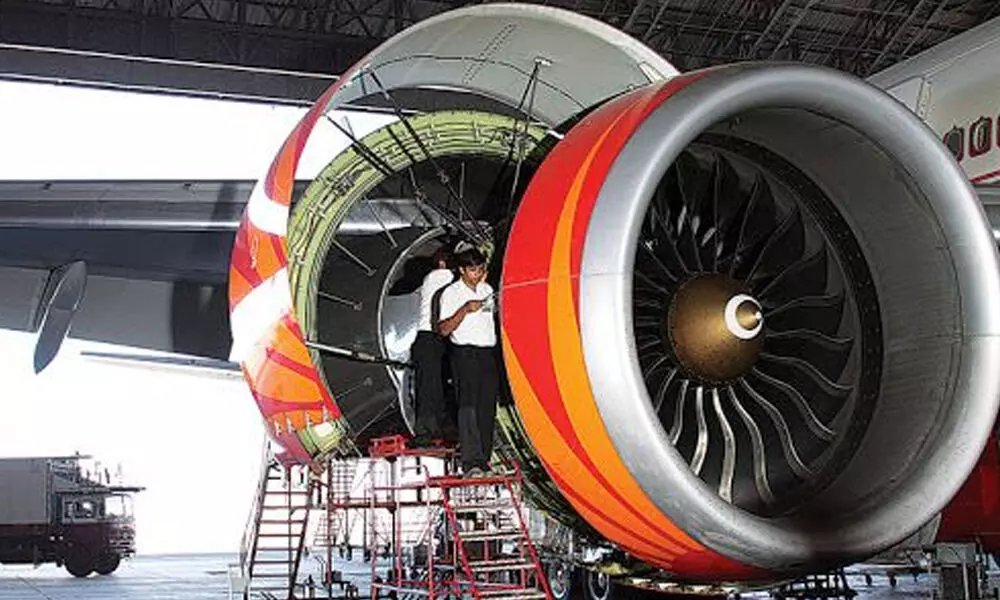India's MRO market size to reach $4 bn by 2031
The global market size is estimated to cross $100 billion by 2030
image for illustrative purpose

The maintenance, repair, and overhaul (MRO) market in India was forecasted to worth around $1.7 billion in 2021. The MRO market comprised of engines, airframe, components, and line, with engine having the major share. The total MRO market size was expected to reach $4 billion in 2031.
The maintenance repair operations industry was valued at $619.01 billion in 2020 and is expected to reach $631.56 billion by 2026 at a CAGR of 2.2 per cent during the forecast period (2021 - 2026). The growing concern for increasing internal efficiency, growing digitisation, and increasing investment in the maintenance operations are some of the major factors driving the maintenance, repair, and operation (MRO) market.
On an average, MRO spend accounts 9-12 per cent of airlines' operational costs and with a 3-5 per cent increase per annum, the global market size is estimated to cross $100 billion by 2030.
MRO services were taxed at 18 per cent while the same services if done overseas attracted a tax of 5 per cent. Additionally, no customs duties were levied on import of MRO services from overseas. The nature of the taxation was such that 90 per cent of India's MRO requirements were imported.
Recently the government slashed the new rates of taxation the 18 per cent tax now slashed to 5 per cent. Further, the place of supply for B2B MRO services is now considered as the location of recipient. This move not only reduces taxes for India's MRO providers but also provides them full input tax credit (ITC). At the same time, foreign MROs continue to not be eligible for Input Tax Credit (ITC) as opposed to their Indian counterparts. The issues of subcontracting and taxation thereof have also been addressed.
Setting up an MRO requires a high capital and constitutes a long break-even time. India constitutes less than one per cent of the entire global industry which caters to commercial travel, goods supply and defence. Reducing duties is a strategic move towards ensuring that India captures a higher share of the global market.
Within the MRO services there are four main segments. Namely: airframe maintenance, engine maintenance, components maintenance and daily and weekly checks of aircraft. Of this, one the most lucrative segment is that of engine overhauls. Indeed, engines and airframes constitute around 50-55 per cent of the work by value. Civil Aviation is expected to give many opportunities in India. Currently as a country we are having 630 commercial aircrafts (Subtracting Jet Airways 100 Aircrafts compared to 3500 aircraft in China and more than 7000 aircraft in USA
By 2023 aircrafts in India is expected to grow in substantial numbers and India may become third largest International aviation market in the world. With current increasing trend in number of civil aircrafts and requirement of maintaining turnaround time (TAT) pushes lot of aerospace activities needed to be carried out within the country. Further many of aircraft parts fall under Dangerous Goods (DG) category especially safety related equipments; hence maintenance of such component outside India will be a costly affair due to very high logistic cost. In such cases airlines prefer to keep such product maintenance within India as it is cost effective.
"Digital MRO Market by Technology (Predictive Maintenance, AR/VR, 3D Printing, Blockchain, Artificial Intelligence, Robotics, Big Data Analytics, Digital Twin, IOT), End-User (MROs, Airlines, OEMs), Application, is projected to grow from $ 606 million in 2020 to $ 1,809 million by 2030, at a CAGR of 11.6 per cent from 2020 to 2030. This growth can be attributed to the increasing adoption of advanced solutions by small and medium airlines and MROs.
The Airports Authority of India (AAI) recently identified land for MROs at various airports including in New Delhi, Chennai, Chandigarh, Begumpet, Bhopal, Kolkata and Tirupati.
Airports in India charge a minimum 13 per cent royalty on MRO firms' annual revenue, thus reducing their profit margin.
The potential for developing a domestic MRO sector is immense, especially given the steep growth curve the in-service aircraft fleet of Indian airlines expects to achieve. Despite the temporary hiatus due to the Covid-19 pandemic, the in-service fleet anticipates a compound annual growth rate (CAGR) of 5 per cent p.a. against the pre-Covid-19 estimate of 8 per cent per annum over the next five years.
The Indian subcontinent represented 3 per cent of that global fleet (980 aircraft), and India alone represented approximately 2.3 per cent (702 aircraft). With the current pending order book of around 900 aircraft for Indian airlines, the underlying market prospects are huge.

